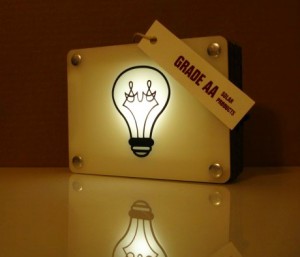Villagers of Wagharwadi till now knew how to make most of the daylight. This village is in Maharashtra, India. They used plastic plates as skylight. This kind of skylight helped women to recognize the ingredients stocked in their kitchens. After evening, villagers depended on candles and kerosene lamps. If some emergency or calamity forced to get some more light in the night they resorted to burning dry twigs. People living in the developed countries would find it a bit difficult to imagine such a situation.

Now the villagers of Wagharwadi are experiencing a revolution of sorts on communication front too. Actually a modified solar lamp has changed their lives. This solar lamp has a tiny plug point at the base for recharging mobiles. It is the idea of an electronics entrepreneur Kumaar Thakkar. Earlier the same villagers didn’t show much enthusiasm about solar lamps only. They complained that solar lamps are too costly for them. Its price was Rs. 1,600, roughly amounting to $34. Now almost every household is the proud owner of the solar lamp. Pandhari Nuruti Basme, a 21-year-old who sells solar lamps in the village, expresses his opinion, “After Kumaar sahab rigged the lamps to power mobile phones, they’re in great demand,”
How this modified solar lamp has caught the imagination of villagers? Imagine if you want to talk to your friends or near and dear ones, you have to take a walk to another village which has phones. Or if you have a mobile of your own you have to walk to another village to charge your mobile and have to pay a fee for charging. Sometimes one has to walk for an hour one way! Now Shivram Bhagat, a 23-year-old who ferries people from Kasara to Goti, has three ‘mobiles’! Once the villagers got news of the ‘mobile-charging batti’ (lighting device), not only an upsurge in the lamp sales was reported but mobile phones too! “Eight of the 17 houses in Wagharwadi have mobiles,” Bhagat says. “We have pre-paid connections and monthly top up for Rs 50.”
Kumaar introduced his solar lamps to the villagers few years ago. Those lamps worked on 30 LEDs (light emitting diodes) and a six volt battery to dispel darkness in the village. He donated five lamps to the local ashramshala (charity home), and offered to sell more to the villagers.
Only well-off villagers, who worked at construction sites or with the railways at Shahapur, Igatpuri and Kasara, opted out for the solar lamps. Dharma Goma Bhagat, who walks three hours to work in Kasara and back everyday, says, “I had to buy the lamp even though it is expensive. There’s no electricity, so what choice did I have?” Those who couldn’t afford to pay the money outright were offered the lamp on instalments of Rs 100 (roughly $2) a month. Pandhari, who is responsible for converting 10 of the 17 houses in Wagharwadi to solar power, says, “The battery lasts up to 12 hours in summer and four hours during the monsoon.” says. He has, to date, sold 60 lamps.
Now if we look at the statistics, solar lamps save villagers the Rs 100 (approx $2) they were spending every month on candles and kerosene. They were also spending Rs 1,200 ( approx $25.93) annually on fuel. Now they can get 10 years of light for Rs 1,600 (approx $34.58). They are also fewer incidents of accidental fires, respiratory problems and failing vision. Now villagers can indulge in indoor activities for a longer period of time. “All they have to do is leave the solar panel on their roof through the day,” says Pandhari, who has learned to fix minor problems like a broken switch.
Now villagers are indulging in another activity too. Through their own tinkering they have discovered another advantage of solar lamps. They are plugging a tiny six-volt television into the solar socket, and watching TV. Pandhari may consider marketing mini TVs now.
Video


 Follow
Follow
